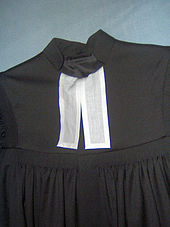Beffchen

The Geneva bands ( lat. Biffa "cravat") is a since the 17th century at the neckline worn 10-15 cm long rectangular piece of white linen.
history
The cup is a remnant of the smaller collar that used to be worn under the so-called " millstone collar". From 1680 a neck band with two strips of linen hanging down on the chest, only a few centimeters wide, was part of the bourgeois costume of men, comparable to the jabot , and was by no means the official costume of the Lutheran pastor in worship. Only in the 19th century was by the order of King Friedrich Wilhelm III. the little cup with a black robe to the liturgical garment in Protestant worship.
Until the 19th century, colored beefs (black, purple) were common in certain costumes of Roman Catholic and Old Catholic clergy. In the costume of the French abbés of the 18th century, for example, a black or dark purple robe or men's skirt (Justaucorps) is accompanied by a white border. To this day, the black gown with white beef is a traditional costume of the brothers of the Christian schools .
Protestant costume
In the official costume of the evangelical clergy in the German-speaking area, the white cup has been preserved to this day. Here it is a permanent accessory of the gown and has the function of a distinguishing feature in the public perception .
The Geneva bands consists of two strip of white material, depending on the denomination diverge the parson or sewn together: While pastors Lutheran the strips about diverge denomination at an angle of 30 °, they are useful in German Reformed firmly joined together, at Swiss Reformed However, as in separated from the German Lutherans. In addition to these two, there is a third form in which the strips are firmly connected in the upper half, but not in the lower half. This form is worn by clergymen of the Evangelical United Churches who feel connected to both the Lutheran and the Reformed creed. A special form of the uniate cup can be found in the Evangelical Church in Baden . Here the two strips are unconnected, but arranged so that they overlap slightly so that it splits in the middle when worn. In the Independent Evangelical Lutheran Church , only carrying the Lutheran bag is covered by the church regulations.
Cups are usually unadorned, but sometimes also lavishly designed with hemstitching or embroidery and decorated with symbols . There are bags for tying and buttoning; often they are simply tucked into the collar of the gown. It is up to the pastor to choose which cup the pastor uses - within the framework of the respective regional church dress codes.
Originally the cup was intended to protect the gown from the clergyman's beard. This protective function is often no longer needed, but the little cup is still part of the official costume. After the introduction of the ordination of women , the pastors in some regional churches are free to choose whether they want to carry a small cup or not. If you decide against wearing the monkey, you usually wear a white collar tucked over your gown.
The jabots worn by the judges of the Federal Constitutional Court are similar to the Beffchen .
Pierre-Joseph Alary . Painting by Claude Pougin de Saint-Aubin (1730–1783) - Archives de l'Académie Française
Jean Baptiste de La Salle (before 1700)
August Hermann Francke (around 1700)
George Pretyman Tomline , Anglican Bishop (around 1800; in the regalia of the Order of the Garter )
Eduard Jakob Wedekin , Catholic Bishop of Hildesheim (around 1860)
Nikolaus Schneider (* 1947)
Web links
Individual evidence
- ^ Royal Prussian Cabinet Order of March 20, 1811; quoted by: Walter Lotz: The wedding dress. On the question of liturgical vestments in Protestant worship (= In the service of the church. Vol. 6, ZDB -ID 978716-1 ). Stauda-Verlag, Kassel 1949, p. 40 f.
- ↑ Illustrations of the school brothers' habit: 1 , 2 , 3
- ^ Gerhard Krause, Gerhard Müller: Theologische Realenzyklopädie, Volume 13, p. 165.







